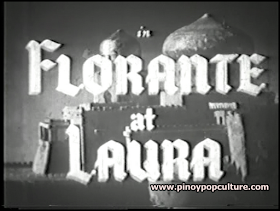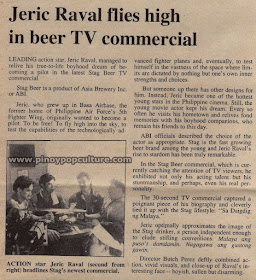The April 24, 1994 issue of the Philippine Daily Inquirer had an article about action star Jeric Raval's endorsement of Stag Beer, a brand manufactured by Asia Brewery Inc.
Jeric Raval, born Jericho Buensuceso, was a contract star of OctoArts Films. He is known for starring in movies including Boboy Salonga: Batang Tondo, Biboy Banal: Pagganti Ko ... Tapos Kayo!, and Bunso: Isinilang Kang Palaban.
It can be noted that the caption did not mention that actor Richard Quan is situated second from left in the photograph.
PINOY POP POTPOURRI ... Personal take on Filipino popular culture (movies, TV, etc.)
Pages
▼
Monday, April 30, 2012
Sunday, April 29, 2012
"Bahay Kubo" Song to a Botanist
Bahay Kubo is a folk song that is well-known among Filipinos of all ages and walks of life. The song describes a nipa hut surrounded by vegetables. Following are the lyrics:
Bahay kubo, kahit munti,
ang halaman doon ay sari-sari:
singkamas at talong, sigarilyas at mani,
sitaw, bataw, patani,
Kundol, patola, upo't kalabasa,
At saka mayroon pang labanos, mustasa,
sibuyas, kamatis, bawang at luya.
Sa paligid-ligid ay puno ng linga.
Here is my English translation of the famous song:
Bahay kubo, kahit munti,
ang halaman doon ay sari-sari:
singkamas at talong, sigarilyas at mani,
sitaw, bataw, patani,
Kundol, patola, upo't kalabasa,
At saka mayroon pang labanos, mustasa,
sibuyas, kamatis, bawang at luya.
Sa paligid-ligid ay puno ng linga.
Here is my English translation of the famous song:
Saturday, April 28, 2012
Fruits from the Calamansi Shrub
Our backyard has a wide variety of fruit-bearing plants, one of which is the calamansi or calamondin (Citrofortunella microcarpa). Calamansi fruits have many uses.
The juice from the green fruits of this shrub can be made into a refreshing beverage. Other culinary applications include the combination of the juice with condiments such as toyo (soy sauce) and patis (fish sauce).
As a laundry aid, the juice can also help in removing stains from clothes.
Following are images of the shrub and the fruit:
The juice from the green fruits of this shrub can be made into a refreshing beverage. Other culinary applications include the combination of the juice with condiments such as toyo (soy sauce) and patis (fish sauce).
As a laundry aid, the juice can also help in removing stains from clothes.
Following are images of the shrub and the fruit:
Monday, April 23, 2012
Some Reminders of Summer
Lately, many of us have been experiencing the hot weather in the Philippines, which tells us that summer is on its heyday. Now that I'm of working age, summer reminds me of those times that I have a long vacation from school every year.
Friday, April 6, 2012
Crucifixion in Kapitangan
Every Good Friday, the Crucifixion of Jesus Christ is re-enacted in Kapitangan, a village in the town of Paombong in the Philippine province of Bulacan.
The area below the platform where the crucifixion was packed with people. I only managed to take the video about 100 meters away.
Thursday, April 5, 2012
Notes on the New 20-Peso and 200-peso Banknotes
The New Generation Banknote Series of the Philippine peso were released in December 2010. Among these banknotes, the 20-peso and the 200-peso bills gained my interest.
Wednesday, April 4, 2012
John Lloyd Cruz, Angel Locsin, and the Manila Bulletin
John Lloyd Cruz and Angel Locsin starred in ÜnOfficially Yours, the recent blockbuster from Star Cinema. In this film, Macky (played by Cruz) is a young man who had a one night stand with Ces (Locsin). They later met at the office of a newspaper company, when Macky found work as a reporter. Ces trained him on the rudiments of journalism.
Sorry to disappoint other readers, but I'll not delve into the juicy details of the movie's plot. I will discuss something we see everyday.
Sorry to disappoint other readers, but I'll not delve into the juicy details of the movie's plot. I will discuss something we see everyday.
Tuesday, April 3, 2012
My Fair Lady reads The King's Speech: Learning How to Speak in English
The title of this post might indicate a misplaced article, but it is not. The importance of English in Filipino culture cannot be understated considering that it is one of our official languages. I would like to share with you two Oscar-winning films that delve on how to properly speak in English: My Fair Lady and The King's Speech.
My Fair Lady is a 1964 musical film adaptation of the similarly-titled stage musical by Frederick Loewe and Alan Jay Lerner. The film's title character, Eliza Doolittle, is a Cockney flower girl who is provided with speech lessons from the phoneticist Henry Higgins. The lessons were given after Higgins' friend, Colonel Pickering, wagered that Higgins will fail on passing off Eliza as a duchess at an embassy ball.
The King's Speech is a 2010 historical drama film about the struggle of the King George VI to overcome a stuttering condition. With the help of Australian speech therapist Lionel Hogue, the king successfully gave his radio broadcast on Britain's declaration of war on Germany in 1939.
Both films depicted montages of the title characters having their speech lessons. The scenes resonate within me very well, because I am exerting efforts to improve my oral communication skills in English. I presume many other Filipinos can relate with my goal to become confident in speaking in English, and the films I mentioned can provide insights into the beauty of the language.
My Fair Lady is a 1964 musical film adaptation of the similarly-titled stage musical by Frederick Loewe and Alan Jay Lerner. The film's title character, Eliza Doolittle, is a Cockney flower girl who is provided with speech lessons from the phoneticist Henry Higgins. The lessons were given after Higgins' friend, Colonel Pickering, wagered that Higgins will fail on passing off Eliza as a duchess at an embassy ball.
The King's Speech is a 2010 historical drama film about the struggle of the King George VI to overcome a stuttering condition. With the help of Australian speech therapist Lionel Hogue, the king successfully gave his radio broadcast on Britain's declaration of war on Germany in 1939.
Both films depicted montages of the title characters having their speech lessons. The scenes resonate within me very well, because I am exerting efforts to improve my oral communication skills in English. I presume many other Filipinos can relate with my goal to become confident in speaking in English, and the films I mentioned can provide insights into the beauty of the language.
Monday, April 2, 2012
Francisco Balagtas' Most Famous Work
Two hundred and twenty-four years ago today, the life of the great Filipino poet Francisco Balagtas (born Francisco Baltazar y dela Cruz) began in the barrio of Panginay in Bigaa (now Balagtas), Bulacan. Balagtas ventured into a wide array of literary genres with the epic poem Florante at Laura standing out.
The plot of Florante at Laura may be a nearly-perfect material for a movie or television screenplay. It is as colorful as the life of the author itself, which will be tackled in a future blog.
A tale of romance blends with a story about political usurpation and redemption.
In 1949, the Philippines' LVN Pictures made a movie based on this work by Balagtas.
The significance of the work may resonate in these times of religious intolerance: It highlights the friendship between Florante, the Albanian duke, and Aladin, the Persian prince.
Many educational institutions in the Philippines set Florante at Laura as required reading for the secondary curriculum.
An e-book version of this work may be accessed on the Project Gutenberg Web site.
The plot of Florante at Laura may be a nearly-perfect material for a movie or television screenplay. It is as colorful as the life of the author itself, which will be tackled in a future blog.
A tale of romance blends with a story about political usurpation and redemption.
In 1949, the Philippines' LVN Pictures made a movie based on this work by Balagtas.
 |
| Opening title card |
 |
| Celia Flor as Laura and Leopoldo Salcedo as Florante |
The significance of the work may resonate in these times of religious intolerance: It highlights the friendship between Florante, the Albanian duke, and Aladin, the Persian prince.
Many educational institutions in the Philippines set Florante at Laura as required reading for the secondary curriculum.
An e-book version of this work may be accessed on the Project Gutenberg Web site.
